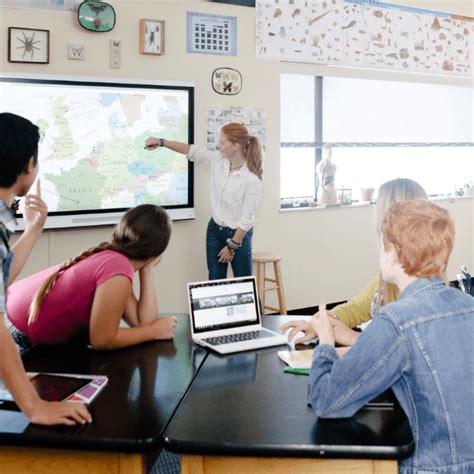Education has undergone a significant transformation with the integration of educational technologies. From interactive digital tools to immersive virtual reality experiences, the classroom has evolved beyond the traditional boundaries. In this blog post, we will explore the various ways in which educational technologies are reshaping the learning environment and curriculum. We will delve into the advantages of blended learning approaches, the use of gamification to increase student engagement, and the integration of personalized and adaptive technologies to cater to individual learning needs. Additionally, we will discuss how online platforms are enhancing collaboration among students and how educators are being empowered with the latest EdTech tools. Moreover, we will address the crucial aspect of accessibility and inclusivity in education and how these technologies are preparing students for the digital future. Join us in this exploration of how educational technologies are revolutionizing the educational landscape.
Table of Contents
Introduction to Educational Technologies
Educational technologies have revolutionized the way students learn and teachers teach. With the rapid advancement of digital tools, education is no longer confined to the traditional classroom setting. Instead, it has expanded into a dynamic environment where technology plays a crucial role in shaping the learning experience.
Today, educational technologies encompass a wide range of tools, from interactive whiteboards and educational apps to online platforms and virtual reality simulations. These tools not only enhance the learning process but also personalize it to meet the needs of individual students.
Moreover, the introduction of educational technologies has paved the way for innovative teaching methods such as blended learning, gamification, and adaptive learning. These approaches not only increase student engagement but also cater to diverse learning styles and abilities.
In conclusion, the introduction of educational technologies has transformed the landscape of education, making learning more interactive, personalized, and accessible. In the upcoming blog posts, we will delve deeper into how these technologies are revolutionizing the learning experience and empowering both students and teachers. Stay tuned for more insights on the exciting world of educational technologies.
Transforming Learning through Digital Tools
With the rapid advancements in technology, the educational landscape has undergone a significant transformation. Digital tools have revolutionized the way students learn and interact with information, providing new opportunities for immersive and engaging learning experiences.
One of the key advantages of digital tools in education is the ability to personalize learning experiences. With the use of adaptive learning technologies, students can receive tailored instruction based on their individual needs and learning styles, allowing for a more effective and personalized approach to education.
Furthermore, digital tools also play a crucial role in increasing student engagement. From interactive multimedia content to gamified learning platforms, these tools have the potential to capture students’ attention and motivate them to actively participate in their own learning process.
Moreover, the integration of digital tools in education promotes collaboration and communication among students and teachers. Online platforms and virtual classrooms enable seamless collaboration and information exchange, breaking down geographical barriers and fostering a more interconnected learning environment.
Advantages of Blended Learning Approaches
Blended learning combines traditional face-to-face classroom learning with online educational resources and tools, offering a variety of benefits for both students and educators. One of the key advantages of blended learning approaches is the flexibility it provides. Students can access course materials and work on assignments at their own pace, allowing them to take control of their learning experience. This flexibility also extends to educators, who can create and deliver content in a way that caters to different learning styles and paces.
Another advantage of blended learning is the ability to personalize the learning experience. With the integration of online resources, students can engage with interactive and multimedia content, tailored to their individual needs and preferences. This personalized approach can lead to increased student engagement and motivation, as well as a deeper understanding of the material being presented.
Blended learning also promotes collaborative learning, as students have the opportunity to engage in discussions and group work both in the classroom and online. This collaboration not only enhances the learning experience but also encourages teamwork and communication skills, which are essential for success in the digital age.
Additionally, blended learning can offer cost savings for educational institutions by reducing the need for physical classroom space and resources. With the use of online platforms and resources, schools and universities can reach a wider audience and offer more flexible learning options without the constraints of traditional classroom settings.
Increasing Student Engagement with Gamification
Gamification is the implementation of game elements and principles in non-gaming scenarios, and it has gained popularity in education as a way to increase student engagement. By integrating gamification into the learning process, educators can leverage the natural competitive nature of students to motivate them and enhance their overall learning experience.
One of the advantages of using gamification in the classroom is the ability to create a more interactive and dynamic learning environment. Students are more likely to be actively involved in the learning process when it is presented in the form of a game, as it taps into their intrinsic motivation and desire to achieve mastery. This can lead to higher levels of engagement and participation, as students become more immersed in the material and are willing to put in the effort to succeed.
Furthermore, gamification can be used to provide immediate feedback and rewards, which are essential components of a successful learning experience. By incorporating elements such as badges, points, and leaderboards, educators can offer recognition and reinforcement for students’ achievements and progress, fostering a sense of accomplishment and motivation to continue learning. This real-time feedback loop can help students stay on track and monitor their own performance, leading to a more self-directed and motivated approach to learning.
In addition, gamification can also promote collaboration and teamwork among students, as many game-based activities require working together towards a common goal. This can help to develop important social and communication skills, and create a sense of community within the classroom. By fostering a collaborative and competitive spirit, gamification can enhance the overall learning experience and contribute to a more engaging and enriching educational environment.
Personalized Learning and Adaptive Technologies
Personalized learning and adaptive technologies are revolutionizing the way students engage with educational content. With the use of adaptive learning platforms, students are able to receive tailored learning experiences based on their individual needs and abilities. This flexibility allows for a more personalized approach to education, catering to the diverse learning styles and paces of each student.
By implementing adaptive technologies in the classroom, educators are able to better address the varying needs of their students. These technologies utilize data-driven insights to provide personalized feedback, scaffolding, and support to students as they navigate through the learning process. This individualized approach fosters a deeper understanding and retention of the material, ultimately enhancing the overall learning experience.
Furthermore, personalized learning and adaptive technologies empower students to take ownership of their education. With the ability to progress at their own pace and receive targeted support, students are more equipped to succeed and build confidence in their abilities. This approach also promotes a growth mindset, encouraging students to embrace challenges and strive for continuous improvement.
In conclusion, personalized learning and adaptive technologies have the potential to transform the traditional classroom into a dynamic learning environment that meets the unique needs of every student. By leveraging these tools, educators can foster a more inclusive and supportive learning experience, ultimately preparing students for success in the digital age.
Integrating Virtual Reality for Immersive Experiences
Virtual reality (VR) has become an increasingly popular tool for creating immersive experiences in various fields, including education. Integrating virtual reality into the classroom can provide students with a more engaging and interactive learning environment.
By using VR technology, students can explore virtual simulations of historical events, scientific concepts, and cultural landmarks, allowing them to experience these subjects in a way that goes beyond traditional textbooks and lectures. This hands-on approach to learning can help to spark students’ curiosity and enthusiasm for the subject matter.
Furthermore, virtual reality can also provide students with the opportunity to interact with their surroundings and manipulate objects in a way that is not possible in the physical world. This can help to reinforce their understanding of complex concepts and improve their retention of information.
Integrating virtual reality into the classroom can also accommodate various learning styles, making education more accessible and inclusive for all students. Whether it’s visual, auditory, or kinesthetic learners, VR technology can adapt to meet the needs of different students, providing a truly personalized learning experience.
Enhancing Collaboration with Online Platforms
Collaboration in the digital age has taken on a new meaning with the advent of online platforms. These platforms provide a space for individuals to work together, regardless of physical location, and have revolutionized the way teams collaborate on projects and assignments. With the ability to share documents, hold virtual meetings, and communicate in real-time, online platforms have become an essential tool for enhancing collaboration in education and the workplace.
One of the key advantages of using online platforms for collaboration is the ability to work asynchronously. This means that individuals can contribute to a project at their own convenience, making it easier to coordinate with team members who may have different schedules or time zones. By removing the constraints of traditional in-person meetings, online platforms enable a more flexible and inclusive approach to collaboration.
Additionally, the use of online platforms can lead to greater transparency and accountability within a team. With features such as version history and activity logs, it becomes easier to track the progress of a project and identify who contributed to specific tasks. This not only fosters a sense of responsibility and ownership among team members but also facilitates constructive feedback and peer evaluation.
Furthermore, the integration of online platforms with other digital tools, such as project management software and file sharing services, enhances the collaborative experience. By consolidating various resources and activities in one accessible location, online platforms streamline the workflow and minimize the risk of miscommunication or disorganization.
Empowering Teachers with EdTech Tools
Teachers play a crucial role in shaping the future of the next generation. With the advancement of technology, educators now have access to a vast array of EdTech tools that can revolutionize the way they teach and empower them to be more effective in the classroom.
One of the primary benefits of EdTech tools is their ability to personalize learning experiences for students. Teachers can use adaptive learning platforms to assess students’ strengths and weaknesses, and tailor their instruction to meet individual needs. This not only helps improve student outcomes, but also gives teachers the satisfaction of knowing they are making a real difference in their students’ lives.
Furthermore, EdTech tools enable teachers to stay up-to-date with the latest educational trends and best practices. Online platforms and resources provide an abundance of professional development opportunities, allowing educators to continuously enhance their skills and knowledge. This ongoing professional growth is essential for teachers to stay inspired and motivated in their careers.
In addition, EdTech tools can streamline administrative tasks for teachers, freeing up more time for instructional planning and student engagement. From gradebooks to communication tools, technology can help educators manage their workload more efficiently, reducing stress and burnout.
Addressing Accessibility and Inclusivity in Education
Educational institutions are increasingly recognizing the importance of addressing accessibility and inclusivity in education. This involves creating an environment where all students, regardless of their abilities or background, have equal opportunities to access and engage with learning materials. By prioritizing accessibility and inclusivity, educators can ensure that every learner can participate and benefit from the educational experience.
One of the key approaches to addressing accessibility in education is through the use of adaptive technologies. These technologies are designed to accommodate a wide range of learner needs, including visual or auditory impairments, physical disabilities, and learning differences. By incorporating adaptive technologies into the classroom, educators can provide personalized support to each student, catering to their specific needs and enabling them to fully participate in the learning process.
In addition to adaptive technologies, it is essential to consider the inclusivity of educational materials and resources. This involves designing learning materials that are accessible to all students, regardless of their individual circumstances. By providing alternative formats for materials, such as audio versions or transcriptions for visually impaired students, educators can ensure that every student has access to the same learning content.
Furthermore, addressing accessibility and inclusivity in education also involves creating a supportive and inclusive classroom environment. Educators can promote inclusivity by fostering a culture of respect, understanding, and empathy among students. By embracing and celebrating diversity, educators can create a learning environment where every student feels valued and included, contributing to a more positive and enriching educational experience for all.
Preparing Students for the Digital Future
As we navigate the ever-evolving landscape of technology, it is essential to consider how we are preparing students for the digital future. The 21st century has brought about unprecedented advancements in digital technologies, and it is crucial that we equip our students with the necessary skills and knowledge to thrive in this rapidly changing environment.
One of the key aspects of preparing students for the digital future is ensuring that they are proficient in digital literacy. This includes not only the ability to use basic digital tools, but also a deeper understanding of how to navigate and critically evaluate the vast amount of information available online. By developing strong digital literacy skills, students will be better equipped to discern credible sources, communicate effectively in virtual environments, and adapt to new technologies as they emerge.
In addition to digital literacy, it is important to integrate coding and programming into the curriculum in order to foster a deeper understanding of how technology works. Coding skills have become increasingly relevant in today’s job market, and by introducing students to coding at an early age, we can empower them to pursue careers in technology-related fields and become active contributors to the digital economy.
Furthermore, preparing students for the digital future involves teaching them how to use technology responsibly. This includes addressing issues such as online safety, digital citizenship, and ethical considerations related to the use of technology. By instilling a sense of responsible digital behavior, we can help students make informed choices as they navigate the digital world and participate as responsible global citizens.





